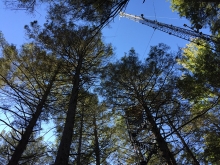You are here
New Study Links Hemlock Decline to Shifts in Water Resources

Each year in New England, tree-killing insect pests cause sweeping changes in forests. Some changes are highly visible – like swaths of dead trees. A new Harvard Forest study points to a less visible but still critical impact: changes to freshwater streams, including streams that source public water supplies.
According to the study, recently published in the journal Geophysical Research Letters, the widespread, insect-induced death of hemlock trees in central Massachusetts has actually increased the amount of water coursing through forest streams – a boost of about 15 percent. The study monitored two stream systems over ten years: one flowing into the Quabbin Reservoir, metro Boston’s public water supply, and the other running to the Connecticut River.
“People are often surprised to learn that trees help to control forest stream flow,” says Emery Boose, co-author of the study and Information Manager at Harvard Forest, where the research was conducted. “The more water trees use for photosynthesis, the less water you’ll find in the streams.”
For nearly two decades, hemlock trees in Massachusetts, which make up anywhere from 10 percent to 60 percent of a forest’s live trees, depending on the location, have become increasingly infested with the invasive hemlock woolly adelgid, an aphid-like insect imported from Japan that slowly kills trees over time. Since the 1950s, the insect has killed millions of hemlock trees across the eastern seabord.
At the Harvard Forest, experiments and long-term monitoring supported by the National Science Foundation’s Long-Term Ecological Research Program have allowed scientists to track the impacts of the adelgid in every aspect of the woods, and to predict what’s coming next.
“The dying hemlocks are producing less food, using less water, and therefore evaporating less water back to the atmosphere, leaving more water available in streams,” says David Orwig, Forest Ecologist at Harvard Forest and a co-author on the study.
But like most environmental change, this effect is not likely to stay the same for long.
Orwig points out that another major shift may be on its way. Hemlock trees, with their evergreen needles, are relatively efficient water users. As hemlocks die, birch trees often grow to replace them. Birches use far more water, especially during the height of the growing season.
“We already see birch seedlings becoming established underneath the dying hemlocks, and if these hardwood trees replace the hemlocks, they may lead to drier conditions and less water in the streams, particularly in mid-summer,” explains Orwig.
The replacement of hemlock by birch will cause other changes, Orwig adds, including a loss of the dense shade and the cooling effect hemlocks have on streams that support cold-water fish like trout. There are also short-term but major increases to the amount of carbon dioxide released by a dying forest. At Harvard Forest, research towers standing in a large patch of hemlocks have tracked these changes since 2000, in research led by Bill Munger at Harvard’s John A. Paulson School of Engineering and Applied Sciences, who also co-authored the water yield study. Additional co-authors on the study came from the University of Massachusetts-Boston, Boston University, and Indiana University-Bloomington.
"It is interesting to think that an insect, barely visible to the naked eye, can not only take down an entire forest of trees, but in the process have profound effects on the ecology and hydrology of the whole system, even affecting water supplies," says Orwig.
- Read the full scientific paper in Geophysical Research Letters: Increased water yield due to the hemlock woolly adelgid infestation in New England.
- Learn more about Harvard Forest research on invasive pests, plants, and pathogens.

